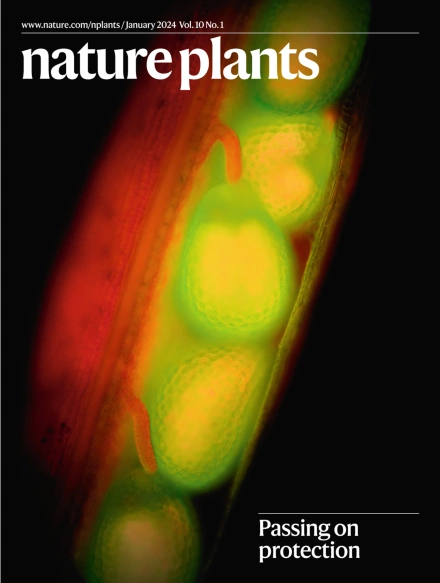poltergeist -样2 (PLL2)依赖的草食动物防御激活将systemin与其他免疫信号通路区分开来。
IF 13.6
1区 生物学
Q1 PLANT SCIENCES
引用次数: 0
摘要
系统素是植物中发现的第一个信号肽,介导了番茄对昆虫、食草动物和坏死性病原体的抗性1-3。最初,systemin被认为是一种类似激素的远距离信使,可以在远离昆虫攻击地点的地方触发系统防御反应。后来发现它更像是一种植物细胞因子,放大局部伤口反应,产生下游信号,激活远端组织中的防御基因表达4。系统素感知和信号传导依赖于系统素受体sy15。然而,syr1依赖性信号传导的细节以及系统信号传导与其他免疫信号传导途径的区别在很大程度上仍然未知。在这里,我们报道了systemin以syr1依赖的方式激活了捣蛋鬼样磷酸酶PLL2。反过来,PLL2调节质膜上的早期系统反应,包括通过质子泵的调节c端去磷酸化来快速抑制质子泵。研究发现,PLL2对下游防御基因的诱导至关重要,最终有助于昆虫抗性。本文章由计算机程序翻译,如有差异,请以英文原文为准。


Poltergeist-Like 2 (PLL2)-dependent activation of herbivore defence distinguishes systemin from other immune signalling pathways
Systemin, the first signalling peptide identified in plants, mediates induced resistance against insect herbivores and necrotrophic pathogens in tomato1–3. Initially, systemin was conceived as a hormone-like, long-distance messenger that triggers systemic defence responses far from the site of insect attack. It was later found to rather act as a phytocytokine, amplifying the local wound response for the production of downstream signals that activate defence gene expression in distant tissues4. Systemin perception and signalling rely on the systemin receptor SYR15. However, the specifics of SYR1-dependent signalling and how systemin signalling differs from other immune signalling pathways remain largely unknown. Here we report that systemin activates the poltergeist-like phosphatase PLL2 in a SYR1-dependent manner. PLL2, in turn, regulates early systemin responses at the plasma membrane, including the rapid inhibition of proton pumps through dephosphorylation of their regulatory C-termini. PLL2 was found to be essential for downstream defence gene induction, ultimately contributing to insect resistance. The phosphatase PLL2 was identified as a specific component in systemin-induced immune signalling. PLL2 regulates proton pump activity at the plasma membrane and is required for downstream defence gene induction and insect resistance.
求助全文
通过发布文献求助,成功后即可免费获取论文全文。
去求助
来源期刊

Nature Plants
PLANT SCIENCES-
CiteScore
25.30
自引率
2.20%
发文量
196
期刊介绍:
Nature Plants is an online-only, monthly journal publishing the best research on plants — from their evolution, development, metabolism and environmental interactions to their societal significance.
 求助内容:
求助内容: 应助结果提醒方式:
应助结果提醒方式:


